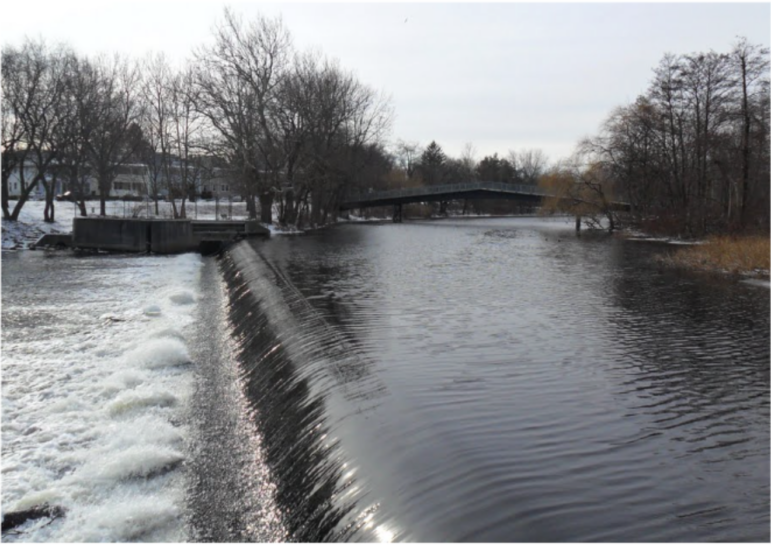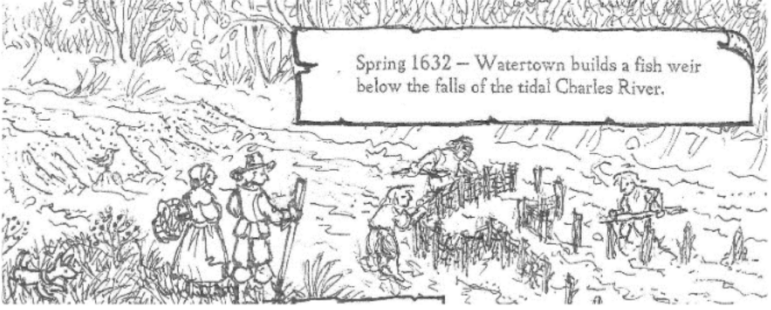
The following story is part of a series on local history provided by the Historical Society of Watertown. It was written by Historical Society President Marilynne Roach for the January 2018 Historical Society newsletter, “The Town Crier.” Marilynne is also on the board of the Watertown Historical Commission.
After Watertown’s early settlers dammed the Charles River to power a grist mill in 1634, more mills followed over the centuries and another dam replaced the first in 1814. This one, according to the Charles River Watershed Association (i.e. CRWA), included a fishway to help the migrating shad and alewives reach their upstream spawning grounds. The present dam dates from 1955 (after Hurricane Diane damaged the older structure) and the present fish ladder from 1972. All of these dams made the fishes’ migrations more difficult. Where early reports noted the great numbers of shad and alewives, recent monitoring indicates that very few shad are able to successfully leap the falls now even with the fish ladder.
In addition, the Office of Dam Safety has rated the aging dam as a “significant hazard” which, if it broke, would cause considerable environmental and property damage.
Consequently, in order to consider the potential removal of the dam, the CRWA applied for and received approval in 2016 from the Department of Fish and Game Division of Ecological Restoration’s Priority Project Program. The CRWA, and the Department of Conservation & Recreation (i.e. DCR), with the help of the Division of Ecological Restoration’s staff, have been researching a feasibility study to estimate what the removal of the dam would involve. According to the article “Group to study removal of dam” in the Watertown TAB, (November 17, 2017), “Due to the historical significance of the site, the CWRA plans to preserve any relevant artifacts found during the dam removal, should the project occur.” Naturally, we at the Historical Society of Watertown can only applaud that decision. Maybe the archaeologists will even find fragments of the original stone dam.
However, nothing in that article or in other pieces found on-line mentioned that the drop in water level at this location was originally a natural feature of the landscape well before the settlers built anything there—certainly a significant detail. When Historical Society of Watertown President Marilynne Roach alerted the CRWA and the DCR of the fact, Bill Hickey (DCR Community Relations) replied that he had passed the information on to the Office of Dam Safety. CRWA Aquatic Scientist Elisabeth Cianciola responded that, as they had wondered if there had been a natural fall at the site, they were pleased to now have the references to confirm it and hope to perhaps find remains of the natural ledge. CRWA is also passing the information along to any consultants that may be involved in the future.

The facts about the fall are these:
The first published reference to the site appears to be in William Wood’s 1634 New-England’s Prospect. Speaking of Watertown when the settlement still clustered just over the present Cambridge border near Mt. Auburn Hospital, Wood wrote:
“A mile and a half from this Town, is a fall of fresh waters, which convey themselves into the Ocean through Charles River. A little below this fall of waters, the inhabitants of Watertown have built a Weir to catch Fish, wherein they take great store of Shads and Alewives.”
Note that Wood calls the feature a “fall” not a dam.
Since a weir needs to be constructed where the tide changes the water level, this one was built near the extent of the tide in the Charles River where the fall prevented any further flow upstream.
According to Governor John Winthrop, as he recorded in his journal under April 1632:
“A weir was erected by Watertown men upon Charles River, three miles above the town, where they took great store of shads.”
The mill complex was built in 1634. On June 22, 1634, Thomas Mayhew wrote to John Winthrop:
“And I do further entreat you to lend Mr. Craddock the help of your team a day or two to help Carry the timber for building the mill at Watertown.”
So, this is what the record tells us for certain:
• Watertown was founded in 1630.
• Wood refers to “a fall of fresh water” rather than a dam, so the mill had not yet been built when he visited the area in 1632 (when the weir was constructed) or shortly thereafter.
• Wood needed time to write his book and return to England by sailing ship.
• Wood’s book was published in London in 1634.
• The mill complex was being constructed in June 1634, the year Wood’s book was published.
• Therefore, the dam was not yet present when Wood described the “fall of waters.”
• This indicates that a natural fall existed before the addition of later construction.
The fall may not have been as high as the present dam which would have allowed easier passage for now endangered migrating fish. But the above facts strongly indicate that to remove the drop in water level completely would obliterate a natural feature that has probably been in place since the glaciers retreated.
Sources (most of them also found on-line):
“The Great Dam at Watertown,” Elisabeth Cianciola, Newton Conservators Newsletter, Summer
2017
“Group to study removal of dam,” Watertown TAB, November 17, 2017
William Wood, New-England’s Prospect, 1634.
John Winthrop, The History of New England from 1630 to 1649. John Winthrop. James Savage editor, 2 volumes. Boston: Little, Brown and Company, 1853. 1: 87
The Winthrop Papers, Volume III: 1631-1637. Allyn Bailey Forbes, editor. Boston:
Massachusetts Historical Society, 1943. P. 169